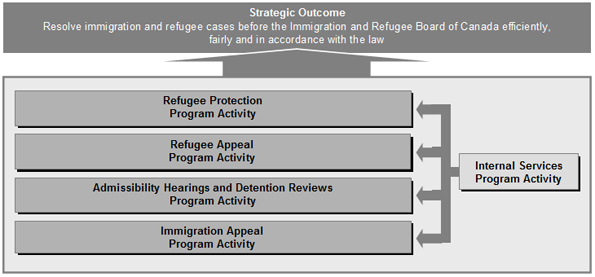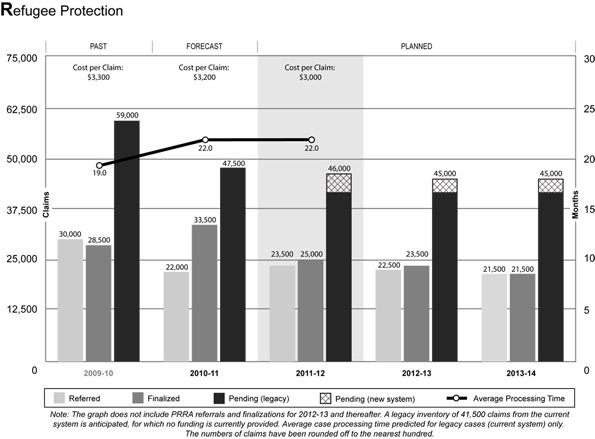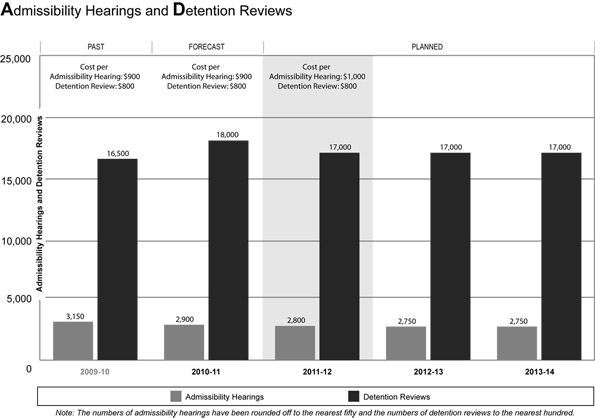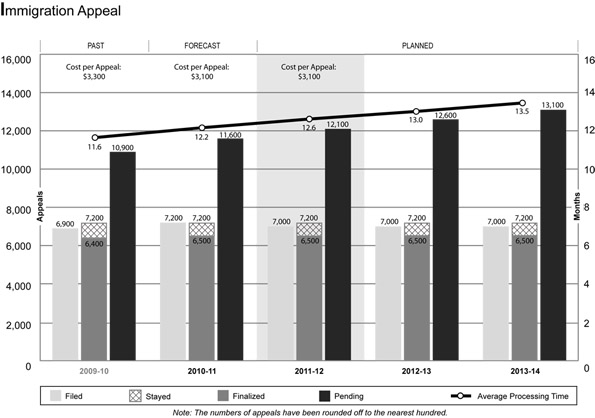Common menu bar links
Breadcrumb Trail
ARCHIVED - Immigration and Refugee Board of Canada - Report
 This page has been archived.
This page has been archived.
Archived Content
Information identified as archived on the Web is for reference, research or recordkeeping purposes. It has not been altered or updated after the date of archiving. Web pages that are archived on the Web are not subject to the Government of Canada Web Standards. As per the Communications Policy of the Government of Canada, you can request alternate formats on the "Contact Us" page.
Section II – Analysis of Program Activities
Strategic Outcome and Program Activities

As discussed in Section I, based on the IRB's legislated mandate and approved PAA, the IRB has a single strategic outcome. Each of the four core program activities are focused on the efficient and fair resolution of the different types of immigration and refugee cases that are before the Board. Combined and supported by Internal Services, they are responsible for all tribunal decisions and case resolutions, and for a successful strategic outcome.
The achievement of the IRB's strategic outcome will be dependent on both the quantity and the quality of the output. For instance, a large number of cases must be finalized every year in order to avoid lengthy delays for individuals waiting for a decision on their case. At the same time, the quality and fairness of each decision must be assured.
The following pages further describe these program activities, identifying expected results, performance indicators and targets, as well as outlining the resources dedicated to each of the five activities.
Program Activity 1: Refugee Protection
Description
The Refugee Protection Division (RPD) delivers the IRB's Refugee Protection program activity. It determines claims for refugee protection made in Canada. Processing of refugee protection claims is the main focus of the IRB's activities and resources. Through the work of the RPD, Canada fulfills its obligations as a signatory to a number of international human rights
conventions.
Additional information on the RPD is available at
www.irb-cisr.gc.ca/eng/tribunal/rpdspr/pages/index.aspx
| Human Resources (FTEs) and Planned Spending ($ Millions) | |||||
| 2011-12 | 2012-13 | 2013-14 | |||
| FTEs | Planned Spending | FTEs | Planned Spending | FTEs | Planned Spending |
|---|---|---|---|---|---|
| 582 | 75.0 | 415 | 44.4 | 413 | 42.8 |
| Expected Result | |
| Quality decisions rendered and cases resolved in a timely manner regarding refugee protection claims made in Canada | |
| Performance Indicators | Targets |
|---|---|
| Clarity, completeness, conciseness and timeliness of decisions | Target is "Meet Expectations", on a scale currently being developed. (With the coming into force of the BRRA, this program activity is scheduled for reform in late 2011. Measurements of decision quality for this program activity will be validated during the last quarter and reporting will begin in 2012-13). |
| Percentage of cases finalized without a hearing | In the current system (until late 2011), it is expected that 5% of cases will be finalized without a hearing (expedited process). See note below. |
| Ratio of finalized cases to referred cases | Approximately 23,500 refugee protection claim referrals are expected to be received in 2011-12. In a combination of the existing and new system, we expect to finalize approximately 25,000 claims. This would result in a ratio of finalized to referred cases of 106%. |
| Average cost per claim finalized | The average cost per finalized claim is expected to be approximately $3,000. |
| Average case processing time | It is expected that the average processing time (from referral to finalization) will stabilize at 22.0 months for legacy claims in the current system. See note below. |
Note: Performance indicators and targets for this program activity in the new system will be developed during 2011-12.
2011-12 Planning Highlights
Reform timelines. As a result of the BRRA, the determination of refugee protection claims will go through a major transition during 2011-12. Cases will continue to be heard in the current system until late 2011, after which the new refugee determination system is expected to come into force.
Preparation for implementation. While case resolution activities continue within the current system, major efforts will be undertaken to prepare for the more efficient and streamlined refugee determination system to begin in late 2011. Decision-makers in the new RPD will be employees appointed in accordance with the PSEA. New rules for refugee protection claims compatible with the BRRA will be adopted. New policies, procedures and processes will be developed and coordinated internally following consultations with stakeholders. Training will also be developed and delivered for a large proportion of RPD personnel.
Case inventory. There will be approximately 47,500 refugee protection claims waiting to be heard at the beginning of 2011-12. This accumulated inventory is well beyond the Division's capacity to address within existing resource levels. As illustrated on the next page, finalizations are expected to slightly exceed referrals during 2011-12. A backlog reduction initiative, with the temporary appointment of additional GIC decision-makers and adjudicative support staff, was put in place during 2010-11. This initiative will continue into 2011-12 until the implementation of the new system. An increase in finalizations over referrals and the backlog reduction initiative are expected to result in a reduction in the case inventory; however, there will still be a substantial number of unfunded pending claims on the date the new legislation comes into force.
Pre-removal risk assessment. The transfer of the PRRA function (except those cases requiring a balancing of the security and protection interests of Canada) from CIC to the IRB will take place no later than 12 months after the other changes to the Refugee Protection program under the BRRA come into force. Although these activities are not expected to begin until 2012-13, planning for the transfer will occur during 2011-12.
Benefits for Canadians
Through the work of the Refugee Protection program activity, Canada provides a safe haven to persons with a well-founded fear of persecution as well as to those facing a danger of torture or a risk to their life, or a risk of cruel and unusual treatment or punishment if returned to their country of origin. This contributes to a safe and secure environment and to Canada's fulfilment of its international obligations.
Program Activity 2: Refugee Appeal
Description
The Refugee Appeal Division (RAD) delivers the IRB's Refugee Appeal program activity. It hears appeals from decisions of the Refugee Protection Division (RPD). The claimant or the Minister can appeal on a question of law, of fact or of mixed law and fact. The RAD will normally proceed without an oral hearing on the basis of the RPD record. The RAD may accept documentary
evidence and written submissions from the Minister and the appellant, and written submissions from a representative of the UNHCR. Under clearly defined circumstances, the RAD may hold an oral hearing.
Note: This program activity is only expected to begin in the last quarter of 2011-12.
| Human Resources (FTEs) and Planned Spending ($ Millions) | |||||
| 2011-12 | 2012-13 | 2013-14 | |||
| FTEs | Planned Spending | FTEs | Planned Spending | FTEs | Planned Spending |
|---|---|---|---|---|---|
| 96 | 14.0 | 264 | 31.3 | 245 | 28.8 |
| Expected Result | |
| Quality decisions rendered and cases resolved in a timely manner regarding refugee protection appeals | |
| Performance Indicators | Targets |
|---|---|
| The BRRA states that the Act may come into force two years after Royal Assent, which was received on June 29, 2010, or at an earlier date that may be fixed by the GIC. At this time, the IRB is planning for the initial phase of this new program activity to begin in late 2011. Performance indicators and targets for this new program activity will be developed during the first three quarters of 2011-12 and will be validated in the last quarter. |
|
2011-12 Planning Highlights
Reform timelines. Cases will only start to flow into the Refugee Appeal program activity when refugee protection claims are decided after the coming into force of the new system. Since new refugee determination system activities in the Refugee Protection program activity are only expected to begin in late 2011, we do not anticipate that a significant level of Refugee Appeal core activities will begin before the end of the fourth quarter of the 2011-12 reporting period.
Preparation for implementation. During 2011-12, the majority of activities will be focused on the development and creation of the new RAD. These include the following:
- Human resources activities will be two-fold as the RAD will be staffed with decision makers appointed by the GIC and public servants in adjudicative support roles. Persons appointed by the GIC who are on strength when the BRRA comes into force can be assigned to the RAD. In the event that the number of GIC appointees on strength is insufficient to fill the anticipated number of positions in the RAD, the IRB will also develop selection criteria and recommend qualified candidates to the Minister of Citizenship, Immigration and Multiculturalism for appointment by the GIC as decision makers. In addition, the IRB will develop selection criteria, recruit and select personnel in accordance with the PSEA for the public service component of the RAD;
- Rules for the conduct of refugee appeal hearings will be developed and submitted for approval by the GIC, and communicated to stakeholders;
- Policies, procedures and processes for the conduct of refugee appeal hearings will be developed and coordinated following consultations with stakeholders;
- Public service and GIC personnel will be trained;
- Infrastructure requirements will be established and addressed.
Benefits for Canadians
Through the work of the Refugee Appeal program activity, Canada provides a safe haven to persons with a well-founded fear of persecution as well as to those facing a danger of torture or a risk to their life, or a risk of cruel and unusual treatment or punishment if returned to their country of origin. This contributes to a safe and secure environment and to Canada's fulfilment of its international obligations.
Program Activity 3: Admissibility Hearings and Detention Reviews
Description
The Immigration Division (ID) delivers the Admissibility Hearings and Detention Reviews program activity. It holds hearings for foreign nationals or permanent residents who, under the provisions of the IRPA, are alleged to be inadmissible to Canada or are detained. Detainees must be seen by the ID within 48 hours after their referral, or without delay thereafter, and
subsequent reviews must be conducted within specific statutory time frames. Decision-makers must balance the right to individual liberty with the security interests of Canadians.
Additional information on the ID is available at
www.irb-cisr.gc.ca/eng/tribunal/idsi/pages/index.aspx
| Human Resources (FTEs) and Planned Spending ($ Millions) | |||||
| 2011-12 | 2012-13 | 2013-14 | |||
| FTEs | Planned Spending | FTEs | Planned Spending | FTEs | Planned Spending |
|---|---|---|---|---|---|
| 82 | 13.6 | 68 | 11.8 | 68 | 11.8 |
| Expected Result | |
| Quality decisions rendered and cases resolved in a timely manner regarding admissibility hearings and detention reviews | |
| Performance Indicators | Targets |
|---|---|
| Clarity, completeness, conciseness and timeliness of decisions | Target is "Meet Expectations", on a scale currently being developed. |
| Percentage of admissibility hearing cases concluded to referred cases | 95-98%1 |
| Percentage of concluded detention review cases within statutory timeframe | 96-98%2 |
| Average cost of admissibility hearing | $1,000 |
| Average cost of detention review | $800 |
| Percentage of admissibility hearings concluded with a hearing within six months from referral | 86-90%1 |
1: Detention reviews take priority over admissibility hearings due to legislative time requirements. The number of referrals from the CBSA affects the capacity of the ID to conduct admissibility hearings.
2: Factors outside the IRB's control, such as prison lockdowns, impede the achievement of 100 percent compliance.
2011-12 Planning Highlights
Sustained and more complex workload. The number of cases concluded by the ID depends largely on the number of cases referred by the CBSA. In its daily activities, the Division must deal with significant fluctuations in the number of detention reviews it is called upon to conduct. Through ongoing efforts to maintain efficiencies, the ID continues to match its output with its intake and to respect legislated time frames.
During 2011-12, it is anticipated that the ID will experience a moderate decrease in referrals for admissibility hearings while the number of detention reviews will remain high. The ID will continue to prioritize detention reviews to ensure that legislative requirements and fundamental rights are respected.
Effective case management. In order to manage its caseload, the ID will continue to monitor scheduling activities to ensure that cases are processed in a timely fashion and that postponed cases are rapidly rescheduled. The continuous monitoring of case management practices will allow the ID to minimize adjournment and postponement rates and to resolve cases in a timely fashion. A sample of decisions will be selected for quality review, the results of which will serve to tailor training programs. Where necessary, corrective action will be taken.
The ongoing use of case readiness measures and follow-up will allow the Division to continue to finalize the vast majority of new admissibility cases within a six-month time frame and maintain a balanced number of admissibility cases in its pending inventory. The Division will continue to promote consistency in decision-making through adjudicative tools such as member forums.
Through ongoing communication and responsible management, the ID strives for a work environment that not only builds on the individual skills and talents of its people but also recognizes their contributions to the organization.
Benefits for Canadians
The ID renders decisions that maintain the security of Canadian society and uphold Canada's commitment to and reputation for justice and fairness for individuals. It is with this sense of responsibility that the IRB maintains the balance between individual rights and the security of Canadians.
Program Activity 4: Immigration Appeal
Description
The Immigration Appeal Division (IAD) delivers the Immigration Appeal program activity. It hears immigration appeals from Canadian citizens and permanent residents whose applications to sponsor close family members to Canada have been refused. Other key functions include hearing appeals from permanent residents, foreign nationals with a permanent resident visa, protected
persons who have been ordered removed from Canada, and permanent residents outside Canada who are alleged to have not fulfilled their residency obligation.
Additional information on the IAD is available at
www.irb-cisr.gc.ca/eng/tribunal/iadsai/pages/index.aspx
| Human Resources (FTEs) and Planned Spending ($ Millions) | |||||
| 2011-12 | 2012-13 | 2013-14 | |||
| FTEs | Planned Spending | FTEs | Planned Spending | FTEs | Planned Spending |
|---|---|---|---|---|---|
| 124 | 14.7 | 124 | 14.7 | 124 | 14.7 |
| Expected Result | |
| Quality decisions rendered and cases resolved in a timely manner regarding immigration appeals | |
| Performance Indicators | Targets |
|---|---|
| Clarity, completeness, conciseness and timeliness of decisions | Target is "Meet Expectations", on a scale currently being developed. |
| Percentage of appeals finalized without a hearing | It is expected that 38% of appeals will be finalized without a hearing. |
| Ratio of finalized appeals to filed appeals | It is anticipated that approximately 7,000 appeals will be filed in 2011-12. We expect to finalize approximately 6,500 appeals resulting in a ratio of 93%. |
| Average cost per appeal finalized | The average cost per appeal finalized is anticipated to be approximately $3,100, depending on the number of appeals finalized. |
| Average appeal processing time | It is expected that the average processing time will increase slightly to 12.6 months in 2011-12. |
2011-12 Planning Highlights
Decision-makers. The IAD's highly trained decision-makers conduct hearings that are varied in appeal type and process. The IAD is committed to effective management in which clear expectations and established performance measures for quality and quantity of decisions are communicated to decision-makers and monitored.
Preparation for reform implementation. The IAD is sharing its experience and technical knowledge in operating an appellate division through the participation of key personnel in the RAD working group and other reform-related implementation committees.
Inventory. The IAD is forecasting an intake of 7,000 filed appeals for 2011-12. The inventory of appeals awaiting finalization will increase slightly to 12,100 by the end of 2011-12. Stayed removal order appeals, forecast at 1,900, are included in that pending inventory. A slight increase in the average processing time is anticipated due, in part, to a reduction in the Alternative Dispute Resolution (ADR) program (linked to pressures on CBSA resources), resulting in fewer early finalizations without a hearing.
Case management. The IAD will continue to respond in a flexible manner to match resources with regional caseloads by sharing decision-makers among regions and by conducting hearings via videoconference where appropriate. Case management strategies will focus on increasing early resolution of appeals without a hearing (pending availability for appeal hearings of CBSA's Minister's counsel), enhancing hearing readiness, scheduling appeals strategically to increase efficiencies, and monitoring reasons for postponements and adjournments. The IAD remains committed to maintaining a high level of productivity and to rendering quality decisions in a timely manner.
Portfolio linkages. The IAD will continue to work with the CBSA to quickly finalize appeals that the CBSA has screened for early resolution and will promote CBSA's continued participation in the ADR program. The IAD will also continue to facilitate the hearing of appeals where the Minister's counsel has chosen to participate through written submissions only. Work undertaken with the CBSA on case management innovations will continue, as always, to respect the adjudicative independence of IAD decision-makers.
Benefits for Canadians
Through its sponsorship appeals work, the IAD recognizes the Government's commitment to family reunification as well as the contributions of immigrants to the strength and vitality of Canadian society and culture. Through its work on removal order appeals, the IAD enhances public safety while maintaining the balance with individual rights.
Program Activity 5: Internal Services
Description
Internal Services are groups of related activities and resources required to support the needs of all four tribunal programs and other corporate obligations of the IRB. These services are: Management and Oversight; Communications; Legal; Human Resources Management; Financial Management; Information Management; Information Technology; Procurement and Assets Management;
Internal Audit and Evaluation; and other administrative services. Internal Services include only those activities and resources that apply across the organization and not those provided to a specific program.
| Human Resources (FTEs) and Planned Spending ($ Millions) | |||||
| 2011-12 | 2012-13 | 2013-14 | |||
| FTEs | Planned Spending | FTEs | Planned Spending | FTEs | Planned Spending |
|---|---|---|---|---|---|
| 302 | 35.7 | 292 | 32.1 | 292 | 32.0 |
2011-12 Planning Highlights
Management and oversight. During 2011-12, the IRB will continue to focus on two areas of management and oversight: staffing and systems development. More specifically:
- The IRB will complete the implementation of the recommendations of a 2009 report of the Public Service Commission (PSC) staffing audit and will conduct its staffing activities in accordance with the PSEA and the PSC's core values of merit, non-partisanship, representativeness, access, fairness and transparency. In this regard, the IRB will continue to implement a staffing monitoring framework that complies with the Staffing Management Accountability Framework (SMAF) of the PSC.
- The IRB will carry out, in collaboration with the Chief Information Officer Branch of the TBS, an independent review of the IRB's STAR Modernization Project. This review will provide assurance to IRB senior management and to the TBS that the project is progressing according to plan.
Communications. During 2011-12, the IRB will continue to engage with key partners, national and international stakeholders, and the public through its Outreach and Communications programs and international activities. Through its work in this area, the IRB will facilitate information and best practice sharing and enhance others' understanding of its mandate and operations to aid in implementing its key initiatives and priorities.
Legal. Legal Services will focus its activities on the development of the new rules for both the RPD and the RAD, as well as providing ongoing advice, support and guidance on all aspects related to the implementation of the BRRA. It will also ensure that any proposed new aspects of operations, service delivery, policy development, corporate direction and management decisions are in compliance with all relevant legal requirements. Legal Services will continue to provide training and support to newly appointed decision-makers and offer advice, including risk analysis, regarding innovative adjudicative strategies. Throughout this period of change, Legal Services will continue to provide substantial support and advice on complex cases involving classified information related to national security or criminal intelligence.
Human resources management. The implementation of the BRRA will continue to drive human resources management activities in 2011-12. The introduction of the new RPD requires the development and implementation of a new organizational structure, work descriptions and staffing and training strategies, as well as learning strategies to support new employees and assure career progression and mobility for existing employees. Additionally, there will be a focus on workplace well-being throughout this period. Attention will also be directed to embedding a monitoring framework for staffing and building HR capacity.
Financial management. During 2011-12, the IRB will focus its efforts on implementing the Policy on Internal Control and its specific obligations related to financial reporting, as well as the new reporting requirements related to the Quarterly Financial Reports and Future-Oriented Financial Statements.
Information management. The IRB currently has an MOU with Library and Archives Canada (LAC) for the storage of files and records. While the MOU will remain in effect during 2011-12, LAC is currently in the process of reviewing its service delivery model. During 2011-12, the IRB will assess the impact for future years and develop records storage options.
Information technology. Information Technology (IT) at the IRB is shaped by new and emerging business priorities and on-going systems and infrastructure maintenance and upgrades. In 2011-12, IT efforts will focus on the modernisation of existing legacy applications in order to support the successful implementation of the BRRA through the capturing and communication of key information to allow for the scheduling, tracking and managing of cases.
Procurement and assets management. The IRB will continue to strengthen its procurement functions by improving processes and providing guidance and training to managers. In addition, the IRB will implement new green directives to ensure environmental assessments are considered when planning the life-cycle process for planned procurement and current IRB assets.
Internal audit. In 2010, the IRB developed a three-year audit plan that meets the requirements of the Office of the Comptroller General of Canada and the TBS Policy on Internal Audit. This audit plan is based on a risk-based methodology, which places significant emphasis on risk management and core management controls, while taking into account the changes to the IRB as a result of the BRRA. The table included in the supplementary information section depicts the audit projects identified under this audit plan from 2010-11 to 2012-13. The IRB's Audit Committee will continue to provide the IRB Chairperson with added assurance and advice, independent from line management, on risk management, control and governance.
Evaluation. As a small department as defined in the TBS Policy on Evaluation, the IRB is not subject to all the requirements of the policy. An evaluation of the IRB's scheduling practices is being used as the basis for the plans to improve the scheduling of IRB proceedings. At the same time, the IRB is laying the groundwork for a five-year evaluation plan based on risk, information needs and the three-year horizontal evaluation of the new refugee determination process led by CIC.



